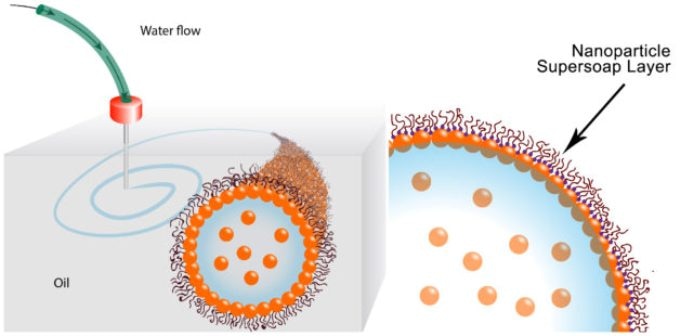Mar 30 2018
A technique for printing 3D structures entirely composed of liquids has been developed by researchers at the Department of Energy’s Lawrence Berkeley National Laboratory (Berkeley Lab). The team employed a modified 3D printer to inject threads of water into silicone oil, thereby sculpting tubes formed of one liquid within another liquid.
 These schematics show the printing of water in oil using a nanoparticle supersoap. Gold nanoparticles in the water combine with polymer ligands in the oil to form an elastic film (nanoparticle supersoap) at the interface, locking the structure in place. (Image credit: Berkeley Lab)
These schematics show the printing of water in oil using a nanoparticle supersoap. Gold nanoparticles in the water combine with polymer ligands in the oil to form an elastic film (nanoparticle supersoap) at the interface, locking the structure in place. (Image credit: Berkeley Lab)
The researchers predict that their all-liquid material can be applied to develop liquid electronics that power up stretchable, flexible devices. They also aim to chemically tune the tubes and make molecules to flow through them, which would result in innovative techniques to isolate molecules or precise delivery of nanoscale building blocks to to-be-developed compounds.
The team has printed threads of water with a diameter of 10 mm to 1 mm, and in a range of branching and spiraling shapes up to many meters in length. In addition, the material can adapt to its surroundings and frequently change its shape.
“It’s a new class of material that can reconfigure itself, and it has the potential to be customized into liquid reaction vessels for many uses, from chemical synthesis to ion transport to catalysis,” stated Tom Russell, a visiting faculty scientist in Berkeley Lab’s Materials Sciences Division. He collaborated with Joe Forth, a postdoctoral researcher in the Materials Sciences Division, and other researchers from Berkeley Lab and various other institutions to develop the material. The study has been published in the Advanced Materials journal on March 24, 2018.
The development of the material was the result of two advancements: discovering a process to form liquid tubes inside another liquid, and subsequently, automation of the process.
For achieving the first advancement, the researchers devised a method to sheathe tubes of water in a distinctive nanoparticle-derived surfactant that arrests the water in place. The surfactant, typically soap, avoids breakage of the tubes into droplets. The surfactant used by the team worked so well that they called it a nanoparticle supersoap.
The supersoap was synthesized by dispersing polymer ligands into oil and gold nanoparticles into water. The polymer ligands and gold nanoparticles try to bind to one another, yet they also try to stay in their respective oil and water mediums. The ligands were synthesized with assistance from Brett Helms at the Molecular Foundry, a DOE Office of Science User Facility located at Berkeley Lab.
Practically, immediately after injecting the water into the oil, dozens of ligands in the oil bind to individual nanoparticles in the water, thus leading to the formation of a nanoparticle supersoap. Similar to glass, these supersoaps coagulate together and vitrify, thereby stabilizing the interface between water and oil and in turn arresting the liquid structures in position.
This stability means we can stretch water into a tube, and it remains a tube. Or we can shape water into an ellipsoid, and it remains an ellipsoid. We’ve used these nanoparticle supersoaps to print tubes of water that last for several months.
Tom Russell
The subsequent advancement is automation. Forth converted an off-the-shelf 3D printer by substituting the components designed to print plastic with a syringe pump and needle for extruding liquid. Then, he programmed the printer to immerse the needle into the oil substrate and inject water in a preset pattern.
“We can squeeze liquid from a needle, and place threads of water anywhere we want in three dimensions,” stated Forth. “We can also ping the material with an external force, which momentarily breaks the supersoap’s stability and changes the shape of the water threads. The structures are endlessly reconfigurable.”
The Department of Energy’s Office of Science funded the study.
Scientists Print All-Liquid 3-D Structures